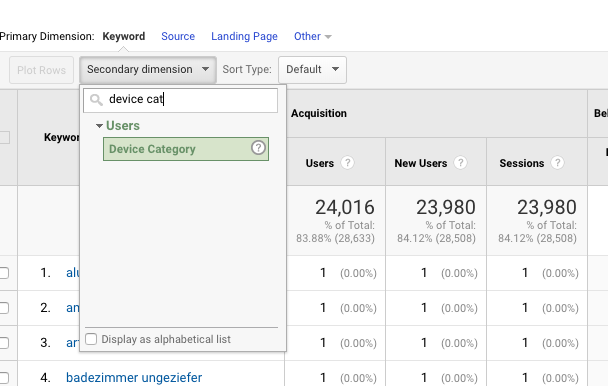Enhance Your Data Evaluation Making Use Of Second Measurement in Google Analytics
Discovering the capacities of additional dimensions in Google Analytics opens a world of possibilities for refining information evaluation. The ability to dissect information better past the surface area degree presents a nuanced sight that can form critical choices. By layering added measurements onto main information collections, an even more complex story emerges, clarifying user interactions and performance signs. This dynamic method to information examination holds the vital to opening concealed patterns and patterns that might change how companies analyze their digital footprint.
Understanding Secondary Dimensions
Secondary dimensions in Google Analytics refer to additional criteria that can be added to the key measurement, permitting for a much more in-depth evaluation of information (Secondary Dimension in Google Analytics). By integrating second dimensions, analysts can section and filter data to reveal patterns, patterns, and relationships that might not be evident when looking at the data as a whole.

Advantages of Using Additional Dimensions
When examining data in Google Analytics, the use of additional dimensions uses indispensable insights into customer actions and performance metrics. By including a second measurement to your key data, you can delve deeper right into the qualities of your site site visitors and their communications. One of the crucial benefits of utilizing secondary measurements is the capacity to segment and contrast data better. This segmentation allows you to understand exactly how various variables, such as demographics or web traffic sources, influence customer actions and conversions (Secondary Dimension in Google Analytics).
In addition, additional measurements assist in determining patterns and connections that may not be right away noticeable when taking a look at the data alone. This much deeper degree of analysis can discover beneficial details that can assist advertising methods, site optimization, and total company decisions. Additionally, additional measurements boost the context of your main data, supplying a more extensive view of individual involvement and performance metrics. On the whole, making use of secondary measurements in Google Analytics can considerably improve the deepness and quality of your information evaluation, causing more educated decision-making and improved outcomes.
How to Add Secondary Dimensions
By integrating second measurements in Google Analytics, customers can get deeper understandings into their data analysis process, permitting for more thorough evaluation of individual actions and efficiency metrics. Including secondary dimensions is a simple process that can considerably enhance the depth of evaluation. When in the report, locate the "Additional measurement" tab above the data table.
Analyzing Data With Secondary Measurements
Using second measurements in data analysis offers a more extensive understanding of user actions and efficiency metrics. By including a secondary dimension to your main information set in Google Analytics, you can dig much deeper into the qualities of your web site site visitors and their communications. Combining the key dimension of 'source/medium' with the second dimension of 'touchdown web page' can expose which specific web pages are drawing in traffic from different resources, helping you maximize these pages for better engagement.

Fundamentally, analyzing information with secondary dimensions encourages you to get beneficial understandings right into individual actions, determine patterns, and make helpful hints notified decisions to improve the performance of your electronic buildings.
Finest Practices for Secondary Measurements
In data analysis, incorporating additional measurements effectively can dramatically boost the depth of insights acquired from metrics and individual habits patterns. When making use of second dimensions in Google Analytics or any kind of other analytical tool, it is critical to stick to finest practices to ensure the precision and importance of the data analysis.
One secret best technique is to very carefully select second dimensions that enhance the main dimension being examined. Picking secondary dimensions that supply additional context or more segmentation can provide an extra detailed understanding of the information. It is also vital to stay clear of overcomplicating the evaluation by consisting of way too many additional measurements, which might cause confusion or dilution of insights.
Furthermore, it is a good idea to explore various combinations of additional and key dimensions to discover new connections and trends. Regularly fine-tuning the option and evaluating of second measurements based upon the particular goals of the analysis can lead to even more workable understandings. By following these best methods, data experts can take advantage of additional measurements effectively to boost the total data analysis procedure and decision-making capacities.

Conclusion
In verdict, including secondary measurements in Google Analytics hop over to these guys is essential for a thorough information evaluation technique. By leveraging secondary dimensions along with primary ones, marketers and analysts can uncover important insights and correlations that can educate decision-making and maximize electronic advertising and marketing methods. Recognizing exactly how to effectively make use Source of secondary dimensions and following best techniques will allow professionals to remove significant information and boost their total performance metrics.
Additional dimensions in Google Analytics refer to extra specifications that can be added to the primary measurement, allowing for an extra detailed evaluation of information. By including second measurements, analysts can sector and filter information to discover patterns, fads, and correlations that may not be evident when looking at the information as a whole. Incorporating the primary dimension of 'source/medium' with the second dimension of 'touchdown page' can reveal which certain pages are attracting traffic from various resources, helping you optimize these pages for much better engagement.
One secret ideal practice is to meticulously select additional dimensions that match the key dimension being evaluated. By adhering to these best techniques, data analysts can leverage secondary dimensions successfully to enhance the overall information evaluation process and decision-making capacities.